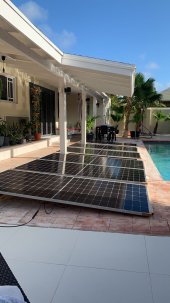Hello Tim, I am back. Everything is connected and ready except the panels. They will be here tomorrow or Friday. I am sorry If I am beating dead horse but I am still not 100% sure I will ground the panels right. Close to the beginning of this thread, I believe you said it would be fine to connect the panels, battery, combiner box and inverter all to my house ground (as you know my house ground is a copper pipe outside). So I trust your experience and I was planning on doing that. However, an inquiry i made to a big well known solar company in US finally replied to me. Their designer team sent me following. Needless to say I am confused again. I tried everything I can to find someone to drill 2 meters in this clay rock hard. It is not possible. Even if possible, the separate ground rod CANNOT be 30 feet away. My lot is to small to allow that. So I see only 2 options. Ground the array, inverter etc with the house ground or don't ground the panels at all. In Aruba we get a few small storms in November December and maybe one lighting, then no rain only sun for many months. So maybe I worry to much. Sorry to bring this up again. If this would be your house here in Aruba with like lava rock soil hard to penetrate, what would you do? Thank you. I forgot to add that tomorrow I am paying a consultation with the best solar company here in Aruba to have their "expert" come to my house and recommend a solution. Can't wait to hear it.
In this instance, you will have two different grounds. One of these grounds is your system ground, which is functionally grounded to your earth ground, aka the house ground that your Growatt is connected to, which is also where your neutral ground bond will be made within your service panel.
The panels on the other hand will need to be grounded separately, with a grounding rod placed approximately 30 feet away from your house where your earth ground is located. This is to escape the earth ground loop that would be created should your panels be grounded too close to your system ground at your house. This is the ground that your combiner box will share as well, and it should be buried at least 6 feet down into the ground.
You will not ground your array to the same earth ground that your inverter and main service panel utilize. This an AC side ground that the array can not, and should not share.




